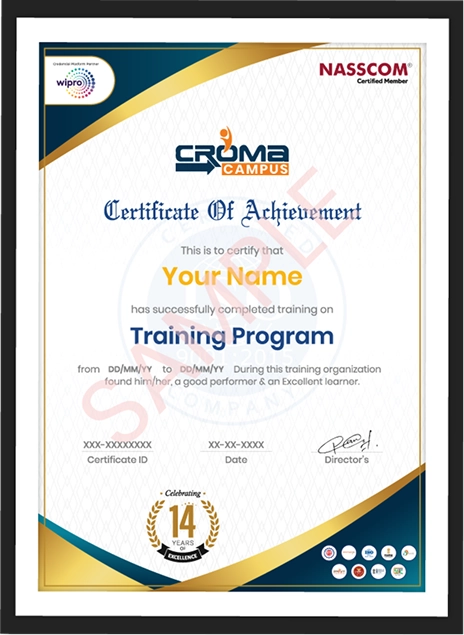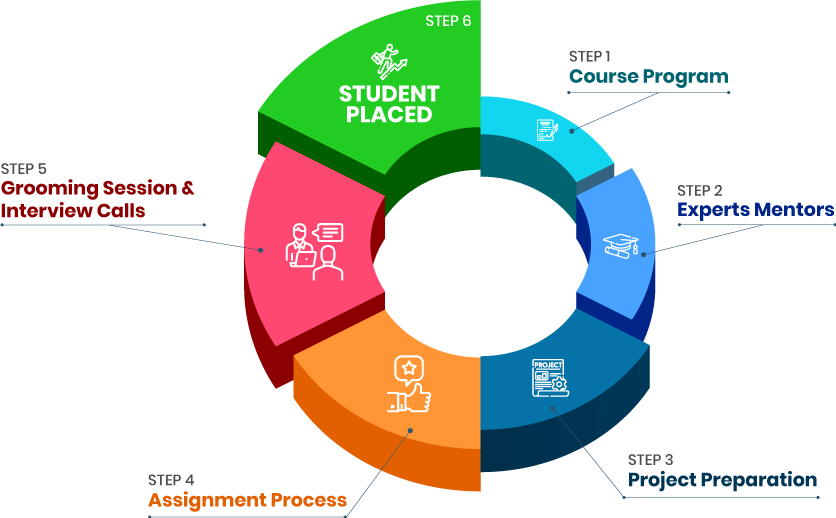Course Design By
Nasscom & Wipro
Data Science Fundamentals: Understand the key principles and methods used to analyze and interpret complex data sets.
Machine Learning Techniques: Learn how to implement various machine learning algorithms for predictive analytics and data-driven decision-making.
Database Management: Gain expertise in efficiently organizing, storing, and retrieving large amounts of data using modern database technologies.
Practical Applications: Work on real-world projects that simulate industry challenges, helping you apply theories to solve actual data problems.
Data Science Management: Learn strategies to manage data effectively within organizations, supporting better industry decision-making.
Starting Salary Range: Entry-level Data Scientists in India typically earn between 6,00,000 and 10,00,000 annually. The variation depends on the company, the city, and the specific skills acquired during the training.
Increased Earning Potential: As you gain more experience and expertise in machine learning, deep learning, data visualization, and programming languages (such as Python and R), salaries can increase to 12,00,000 - 18,00,000 within a few years.
Industry Differences: Different industries offer varying salaries. For instance, tech companies, fintech, and large consulting firms like Deloitte or Accenture tend to offer higher starting salaries, while industries such as healthcare or education may offer slightly lower but still competitive compensation.
Location Impact: Cities like Bangalore, Hyderabad, Mumbai, and Pune are known to have higher salary ranges due to the high concentration of tech companies and startups. In contrast, smaller cities or regions with a lower cost of living might offer salaries in the lower range.
Company Type: Large multinational companies and top tech firms often provide higher salaries, bonuses, and other benefits. Startups or smaller companies offer slightly lower salaries but compensate with other perks like flexible working hours or stock options.
Rapid Advancement: With experience, freshers can move from junior roles like Data Analyst to positions like Data Scientist, Machine Learning Engineer, or Data Engineer.
Specialization Opportunities: As you grow, you can specialize in Natural Language Processing (NLP), deep learning, or AI, often with higher salaries and more challenging projects.
Leadership Roles: With technical expertise and business acumen, you can eventually move into managerial or leadership positions, such as Data Science Manager, Chief Data Officer (CDO), or Head of Data Analytics.
High Demand & Job Security: Data professionals enjoy job security and numerous career opportunities across different sectors due to the increasing reliance on data-driven decisions across all industries.
Industry-Relevant Curriculum: Learn the latest tools, techniques, and trends in high demand in the Data Science industry today. A Data Science Online Course offers a great opportunity to learn from anywhere and at your own pace.
Hands-On Learning: With these Best Online Data Science Course in India you work on real-world data science problems, gaining practical experience that prepares you for the job market.
Placement Support: Our Data Science Online Course in India includes placement assistance to help you find Data Science jobs in India and abroad.
Professional Networking: Connect with industry experts and alums to grow your professional network, which is crucial for career development in Data Science.
Job Market Preparation: The Data Science Online Course in India is tailored to meet the needs of today's Data Science job market, ensuring you're ready to take on real-world challenges.
Skill Development: Focus on mastering the in-demand tools and techniques used by Data Scientists, such as Python, R, and machine learning algorithms.
Career Guidance: Get personalized mentorship and advice on successfully navigating the job search process in Data Science, both in India and internationally.
Growing Relevance: As the demand for data-driven solutions increases, the range of Data Science courses has expanded, providing foundational and advanced knowledge.
Popularity of Online Courses: Online Data Science Classes have gained global recognition. They offer flexible schedules and a comprehensive curriculum that cater to a wide range of learners.
Accessibility of Education: Digital platforms have made Data Science education more accessible, enabling learners to gain high-quality education from anywhere.
Job Growth: The rise in Data Science-related job openings reflects the increasing demand for data professionals across industries.
Booming Job Market in India: The demand for Data Scientists is growing rapidly in India, making it an attractive and lucrative career option for many professionals.
Placement Guarantee Programs: Some Data Science courses provide education and placement assistance, helping students secure relevant positions in the field.
Specialized Roles: These courses cover essential roles like Data Scientist and Data Engineer, giving learners the knowledge and skills required for specific career paths in the industry.
Data Science Courses: These courses provide a strong foundation in understanding and applying Data Science principles, preparing learners for the growing industry demand.
Immersive Online Learning: The best online Data Science courses offer an engaging learning experience, combining theoretical concepts with hands-on practical applications to enhance real-world readiness.
Surging Demand for Data Scientists in India: The demand for Data Scientist roles in India is skyrocketing, driven by the rapid growth of the digital economy and the increasing reliance on data analytics in business strategies.
Wide Industry Adoption: Data Science jobs are no longer confined to tech companies alone; industries such as healthcare, finance, retail, and manufacturing actively seek Data Science professionals to drive their data-driven decision-making.
Placement-Focused Courses: Data Science courses with placement assistance focus on bridging the gap between academic learning and employers' practical needs, increasing students' chances of securing industry-relevant positions.
Emerging Roles: The evolving roles of Data Engineers and Data Scientists are becoming more prominent in curricula, equipping students with the skills required for specialized career paths.
Complete Learning: These best Data Science courses in India cover everything you need to know about Data Science, including the latest tools and techniques used in the field.
Key Topics: The courses usually teach subjects like machine learning, analyzing data, and predicting outcomes, giving you a full understanding of the field.
Flexible Learning: Online courses allow you to study at your own pace, so you can fit learning around your job or other personal commitments.
Interactive: Many courses have live classes, discussion groups, and hands-on projects, making it easier to understand and apply the concepts.
Earn a Certificate: After completing the course, you can receive a certification, which will look great on your resume and can help with career opportunities.
we train you to get hired.

By registering here, I agree to Croma Campus Terms & Conditions and Privacy Policy
+ More Lessons
Course Design By
Nasscom & Wipro
Course Offered By
Croma Campus
Stories
success
inspiration
career upgrade
career upgrade
career upgrade
career upgrade
You will get certificate after
completion of program
You will get certificate after
completion of program
You will get certificate after
completion of program
in Collaboration with

Empowering Learning Through Real Experiences and Innovation
we train you to get hired.
Phone (For Voice Call):
+91-971 152 6942WhatsApp (For Call & Chat):
+91-971 152 6942Get a peek through the entire curriculum designed that ensures Placement Guidance
Course Design By
Course Offered By
Ready to streamline Your Process? Submit Your batch request today!
The main reason to choose the Online Data Science Course in India from the Croma Campus is so that you can grow your skills under the guidance of the corporate trainers that help you too gain the essential skills and knowledge to meet the demands of the organization with perfect solutions.
The Data Science Online Training in India from Croma Campus will help you to learn from the practical and theoretical formats and will also help you to learn from the real time-based projects that will upgrade your profile needed by the fortune organizations.
The Online Data Science Course in India with Certification can be done with Croma campus offering various ways to learn. You can choose any service from:
It takes around 5 to 6 months to learn the course from the Online Data Science Course in India. Also, it depends upon the learner. On an average this time is perfect to learn the course.
To start learning Data Science Online Certification Course in India you can contact to: Email: Info@cromacampus.com Contact no.: +91-9711526942 / +91-120-4155255
The duration of a Data Science course typically ranges from a few weeks for introductory programs to 2-3 years for in-depth degree courses.
Data Science course fees in India vary, starting from around INR 10,000 for basic courses to over INR 2,00,000 for comprehensive and specialized programs.
Topics in a Data Science online course usually include statistics, machine learning, Python programming, data visualization, and big data analysis.
A Data Scientist is a professional skilled in extracting insights and knowledge from data, using techniques in statistics, machine learning, and data analysis.
Yes, this Data Science course can be suitable for freshers, as many courses are designed to accommodate beginners with no prior experience.
A Data Science Management course focuses on combining data science skills with management principles, targeting professionals who oversee data-driven projects and teams.
To enroll in the best Data Science courses, research top-rated programs online or through academic institutions, and follow their application or registration process.
Yes, a Data Scientist job is often categorized under IT, as it involves working with technology and data systems, though it also encompasses statistical and analytical skills.
Eligibility for a Data Science online course varies, but generally, anyone with a keen interest in data and basic analytical skills can enroll. Some advanced courses might require prior knowledge in statistics or programming.
Croma Campus is the Best Data Science Training Institute in India from last two decade.

Highest Salary Offered
Average Salary Hike
Placed in MNC’s
Year’s in Training

fast-tracked into managerial careers.
Get inspired by their progress in the
Career Growth Report.
FOR QUERIES, FEEDBACK OR ASSISTANCE
Best of support with us
For Voice Call
+91-971 152 6942For Whatsapp Call & Chat
+91-9711526942




















